M7U4project教案
- 格式:doc
- 大小:53.00 KB
- 文档页数:3
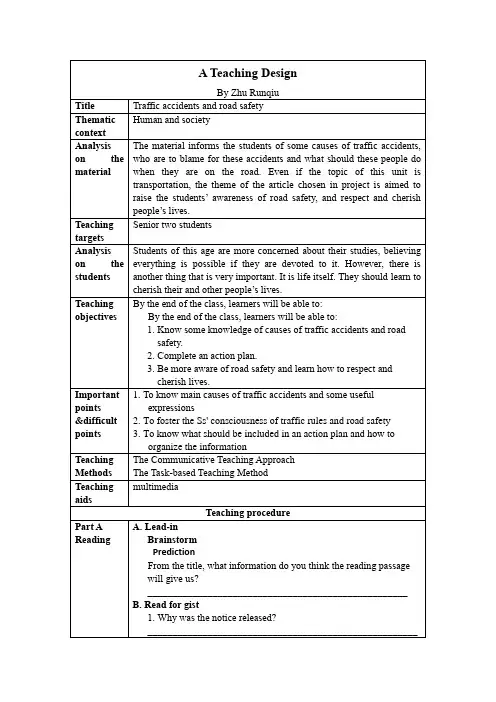
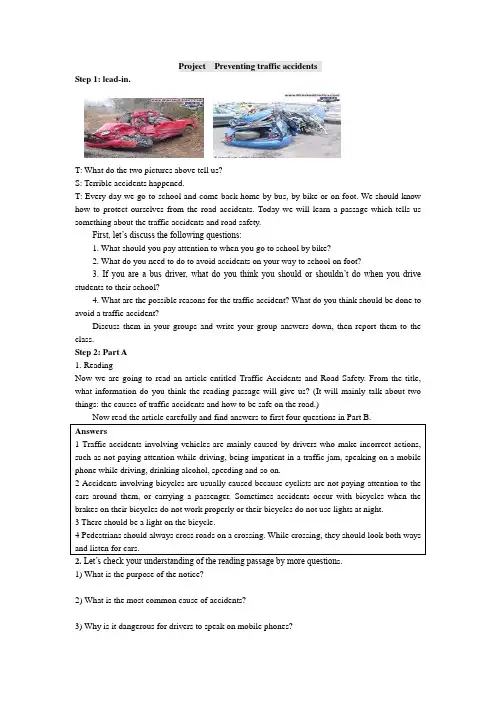
Project Preventing traffic accidentsStep 1: lead-in.T: What do the two pictures above tell us?S: Terrible accidents happened.T: Every day we go to school and come back home by bus, by bike or on foot. We should know how to protect ourselves from the road accidents. Today we will learn a passage which tells us something about the traffic accidents and road safety.First, let’s discuss the following questions:1. What should you pay attention to when you go to school by bike?2. What do you need to do to avoid accidents on your way to school on foot?3. If you are a bus driver, what do you think you should or shouldn’t do when you drive students to their school?4. What are the possible reasons for the traffic accident? What do you think should be done to avoid a traffic accident?Discuss them in your groups and write your group answers down, then report them to the class.Step 2: Part A1. ReadingNow we are going to read an article entitled Traffic Accidents and Road Safety. From the title, what information do you think the reading passage will give us? (It will mainly talk about two things: the causes of traffic accidents and how to be safe on the road.)Answers1 Traffic accidents involving vehicles are mainly caused by drivers who make incorrect actions, such as not paying attention while driving, being impatient in a traffic jam, speaking on a mobile phone while driving, drinking alcohol, speeding and so on.2 Accidents involving bicycles are usually caused because cyclists are not paying attention to the cars around them, or carrying a passenger. Sometimes accidents occur with bicycles when the brakes on their bicycles do not work properly or their bicycles do not use lights at night.3 There should be a light on the bicycle.4 Pedestrians should always cross roads on a crossing. While crossing, they should look both ways and listen for cars.1) What is the purpose of the notice?________________________________________________________________________ 2)What is the most common cause of accidents?________________________________________________________________________ 3) Why is it dangerous for drivers to speak on mobile phones?________________________________________________________________________4) Can cyclists ride on the pavement? Why (not)?________________________________________________________________________ 5) What can we do to prevent accidents?The notice was released because ____________. (the number of accidents and the deaths arising from traffic accidents has increased greatly over the past year)In order to prevent accidents, drivers should_____________________________________;( pay attention to the surrounding traffic)_____________________________________; (be patient in a traffic jam)_____________________________________; (not speak on a mobile phone)_____________________________________; (not drink alcohol)_____________________________________; (not drive too fast)In order to prevent accidents, cyclists should_____________________________________; (always obey traffic laws)_____________________________________; (pay attention to the cars that surround them)_____________________________________; (not carry a passenger)_____________________________________; (have a light on the bicycle at night)_____________________________________; (keep the bicycle in good condition) In order to prevent accidents, pedestrians should_____________________________________; (always cross roads on a crossing)_____________________________________; (look both ways and listen for cars while crossingthe street)_____________________________________; (never ignore traffic lights)Step 3: Part BWork in groups of four or six to discuss the questions 5-8 in Part B. Write down your answers. Then one student from each group presents your answers to the class. Other groups can give your comments.Step 4: Exercises:Complete the sentences with proper words or phrases from the article on pages 62-63 of your book. Change the form where necessary.1) There were 39, 000 new cases last year - an ____________ of 7 per cent.2) He is still standing under the tree, not ____________ the danger.3) My father was ____________ for dangerous driving yesterday.4) He has been ____________ from his job for dishonesty.5) It would be____________ to ignore these warnings.6) Leaving your house unlocked is an open ____________ to burglars7) The western part of China is in great ____________ of teachers.8) Whenever you come into his room, it is always ____________.9) I found it hard to follow what the teacher was saying, and eventually I lost ____________.10) In ____________ cases, the disease can lead to blindness.Step 5: Homework:1. Finish D1 and D2 on page 129 of the Workbook.2. Read the newspaper article in Part B on page 131 of the Workbook to know about an aeroplane accident many years ago.。
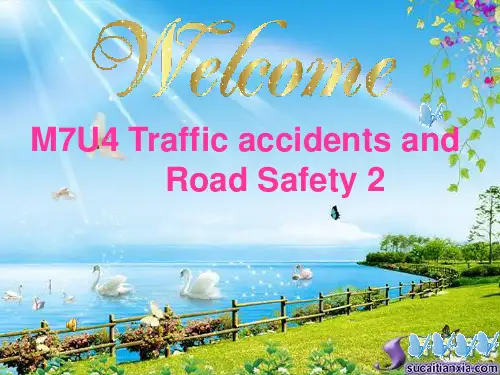
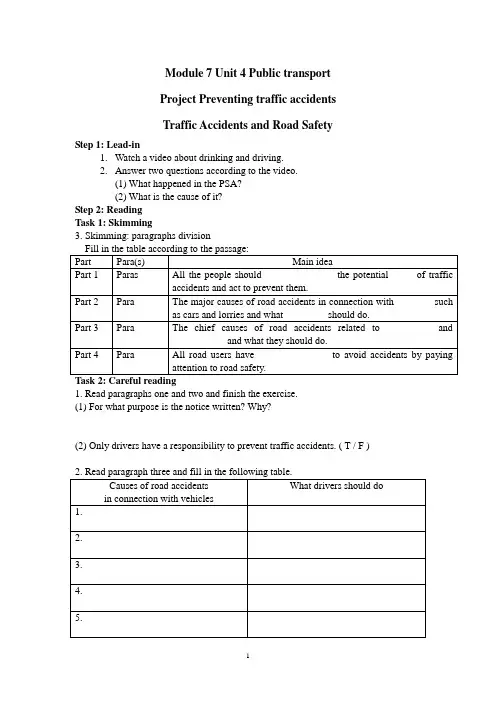
Module 7 Unit 4 Public transportProject Preventing traffic accidentsTraffic Accidents and Road SafetyStep 1: Lead-in1.Watch a video about drinking and driving.2.Answer two questions according to the video.(1) What happened in the PSA? ___________________________(2) What is the cause of it? _______________________________Step 2: ReadingTask 1: Skimming3. Skimming: paragraphs division1. Read paragraphs one and two and finish the exercise.(1) For what purpose is the notice written? Why?_____________________________________________________________________ _____________________________________________________________________ (2) Only drivers have a responsibility to prevent traffic accidents. ( T / F )_____________________________________________________________________Step(1) planningOrganize students into groups of four and assign different jobs to each group member. ☆a group leader: be in charge of group activitypresent the action plan☆Two: write☆One: draw picture(s)Step(2) preparingLet students choose the topics(1) information from the book(2) their own opinionsStep(3) producing1. Let students finish their own job.2. Attach each part to the action plan.3. Beautify it together.Step(4) presenting1. Let students show and describe their action plans.2. If necessary, they can refer to the following when presenting.Good morning, everyone:This is our action plan.First, please allow me to introduce my group members. They are ……Our topic is ……. And ……is our slogan.The picture means that ……To avoid this, we should……/we shouldn’t …… (measures/ advice)。
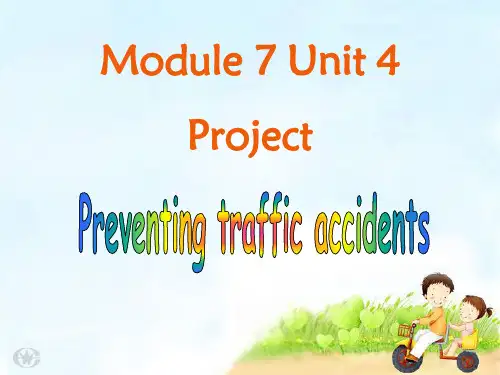
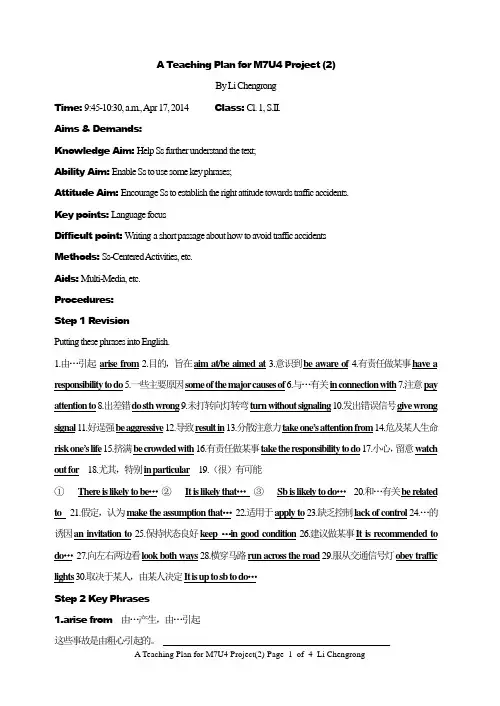
A T eaching Plan for M7U4 Project (2)By Li ChengrongTime: 9:45-10:30, a.m., Apr 17, 2014 Class: Cl. 1, S.II.Aims & Demands:Knowledge Aim: Help Ss further understand the text;Ability Aim: Enable Ss to use some key phrases;Attitude Aim: Encourage Ss to establish the right attitude towards traffic accidents.Key points: Language focusDifficult point: Writing a short passage about how to avoid traffic accidentsMethods: Ss-Centered Activities, etc.Aids: Multi-Media, etc.Procedures:Step 1 RevisionPutting these phrases into English.1.由…引起arise from2.目的,旨在aim at/be aimed at3.意识到be aware of4.有责任做某事have a responsibility to do5.一些主要原因some of the major causes of6.与…有关in connection with7.注意pay attention to8.出差错do sth wrong9.未打转向灯转弯turn without signaling 10.发出错误信号give wrong signal 11.好逞强be aggressive 12.导致result in 13.分散注意力take one’s attention from 14.危及某人生命risk one’s life 15.挤满be crowded with 16.有责任做某事take the responsibility to do 17.小心,留意watch out for 18.尤其,特别in particular 19.(很)有可能①There is likely to be…②It is likely that…③Sb is likely to do…20.和…有关be related to 21.假定,认为make the assumption that…22.适用于apply to 23.缺乏控制lack of control 24.…的诱因an invitation to 25.保持状态良好keep …in good condition 26.建议做某事It is recommended to do…27.向左右两边看look both ways 28.横穿马路run across the road 29.服从交通信号灯obey traffic lights 30.取决于某人,由某人决定It is up to sb to do…Step 2 Key Phrases1.arise from 由…产生,由…引起这些事故是由粗心引起的。
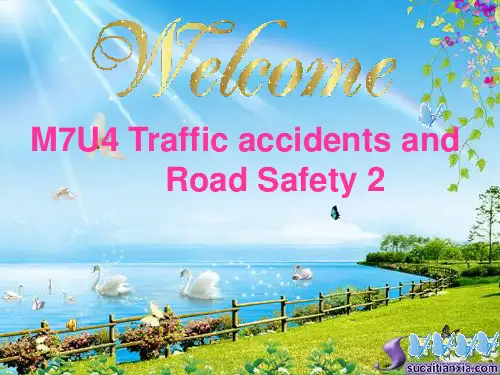
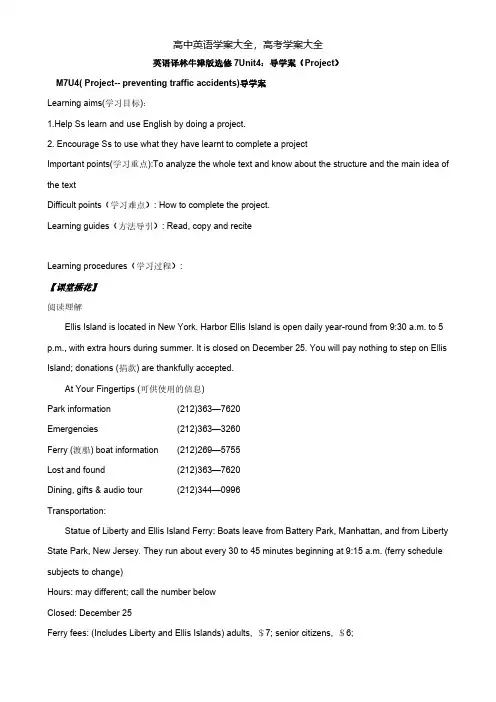
英语译林牛津版选修7Unit4:导学案(Project)M7U4( Project-- preventing traffic accidents)导学案Learning aims(学习目标):1.Help Ss learn and use English by doing a project.2. Encourage Ss to use what they have learnt to complete a projectImportant points(学习重点):To analyze the whole text and know about the structure and the main idea of the textDifficult points(学习难点): How to complete the project.Learning guides(方法导引): Read, copy and reciteLearning procedures(学习过程):【课堂插花】阅读理解Ellis Island is located in New York. Harbor Ellis Island is open daily year-round from 9:30 a.m. to 5 p.m., with extra hours during summer. It is closed on December 25. You will pay nothing to step on Ellis Island; donations (捐款) are thankfully accepted.At Your Fingertips (可供使用的信息)Park information(212)363—7620Emergencies(212)363—3260Ferry (渡船) boat information(212)269—5755Lost and found(212)363—7620Dining, gifts & audio tour(212)344—0996Transportation:Statue of Liberty and Ellis Island Ferry: Boats leave from Battery Park, Manhattan, and from Liberty State Park, New Jersey. They run about every 30 to 45 minutes beginning at 9:15 a.m. (ferry schedule subjects to change)Hours: may different; call the number belowClosed: December 25Ferry fees: (Includes Liberty and Ellis Islands) adults, $7; senior citizens, $6;Children (age 3 to 17), $3.(group rates are available for 25 or more adults)Ticket & schedule information: (212)269—57551. In summer, visitors will have _________ to visit Ellis Island.A. no enough timeB. a longer timeC. a shorter timeD. a wonderful time2. Which number would you call if your friend were suddenly ill?A. (212)344—0996B. (212)363—7620C. (212)363—3260D. (212)269—57553. Which of the following is NOT true?A. People can visit Ellis Island free of charge.B. The boats’ departure time from Battery Park is at 9:15 a.m. all the year round.C. Ferry fees for children are cheaper than for adults.D. Ferry fees for group visitors can be reduced.4. We may infer from the passage that __________.A. visitors prefer to go to Ellis Island by boatB. there are more visitors in winterC. Ellis Island is open every dayD. boat is the only transportation to Ellis Island1. B 细节理解题。
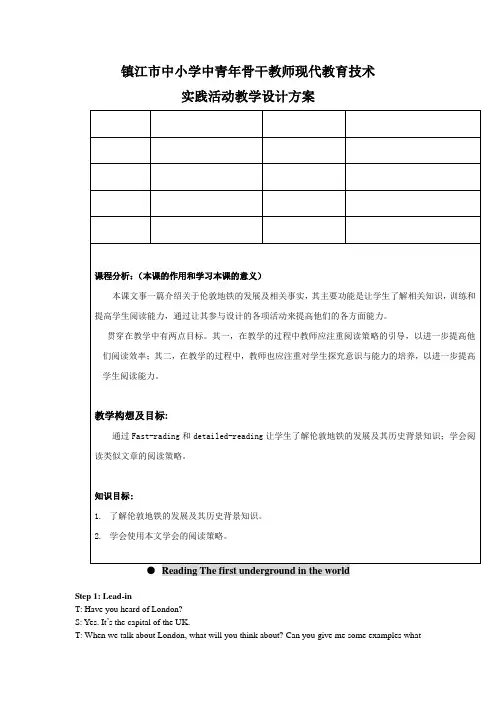
镇江市中小学中青年骨干教师现代教育技术实践活动教学设计方案Step 1: Lead-inT: Have you heard of London?S: Yes. It’s the capital of the UK.T: When we talk about London, what will you think about? Can you give me some examples whatLondon is famous for?S1: The Cambridge University and the Oxford University.S2: London Bridge.S3: the heavy fog.S4: the Big Ben....T: Well done, everyone. In addition to these, the underground system in London is also the oldest and the best in the world. Today we’ll learn something about the London Underground.Step 2: Fast-reading for general idea.Now let’s e to our books. Go through the passage as quickly as possible and try to find answers to the three questions in Part A. While reading, you just need to focus on and identify the informationStep 3: Detailed reading for important information1. Now read the passage again more carefully. After it, you are required to answer the questions of2. In the brochure, the following years indicate the important stages in the development of the London Underground. Listen to the tape and find the information to match the year.Step 4: Practice:1. Let’s plete Part D.Find these words in the text and try to guess their meanings according to the context, and thenZhao Ning wrote an e-mail to a friend to tell him abut her trip to London. Here is part of her3. plete the following passage with proper words or phrases from the article on pages 50-51. Change the form where necessary.The London underground system has the (1) __________ of being the oldest and most plex underground system in the world. Before 1850, train services to London had already been (2) __________, but people couldn’t build railways into the city because doing that would cause great (3) __________ to many historic buildings. So many buses were needed to (4) __________ people to the city centre, which, however, often (5) __________ traffic. This problem led to the development of the underground system.In 1854, Metropolitan Railway pany was allowed to build an underground railway and the first tunnels were opened in 1863. In 1868, the next (6) __________ of the underground system was opened by another pany called the Metropolitan District Railway. In 1884, these two panies (7) __________ and provided the underground service in the middle of the city.With the development of the (8) __________ ways of digging tunnels, the first railway tunnel under the River Thames was dug in 1884, and over the next 25 years, six (9) __________ deep underground lines were made. But because they were (10) __________ owned and far away from each other, traveling on these lines was (11) __________. Having seen the situation, Charles Yerkes, tried to improve the system. He bought many of the different lines and setting up the Underground Group. In 1933, a public (12) __________ called the London Passenger TransportBoard was created, which eventually became London Transport. From 1918 to 1938, the system (13) __________ a lot.During World War II, the underground system had some (14) __________ uses. For example, many underground stations once (15) __________ as bomb shelters. After the war, more lines were added. Now, the network of the underground system includes 12 lines and goes 26 miles out of central London. Three million people travel on the underground every day. Can you imaginesentences.1) It is said that the two panies will cooperate with each other in the future to manufacture the new car.The two panies ____________ ____________ to ____________ ____________ in the future to manufacture the new car.2)They use special chemicals to make crops grow faster.They use special chemicals to ____________ the ____________ of crops.3)Because there existed the traffic problem, the underground system developed.The traffic problem ____________ ____________ the ____________ of the underground system.4) People hold kinds of activities to show respect for Cong Fei, a “father” of 183 poor studentsin the mountain areas.Kinds of activities are held ____________ ____________ ____________ Cong Fei, a “father”of 183 poor students in the mountain areas.5)They have been trapped in the flood caused by the third typhoon this year----Ewiniar. They are worried about the situation.____________ ____________ ____________ in the flood caused by the third typhoon this year----Ewiniar, they are worried about the situation.6) Do you know who is in charge of the design for the Three Gorges Dam Project?Do you know who is ____________ ____________ the design for the Three Gorges DamRead the instructions for Part F and discuss the three questions that follow.Step 6: Language points:Step 7: Homework:1. Prepare the part Word Power2. Read the passages on Page 130 of the workbook.。
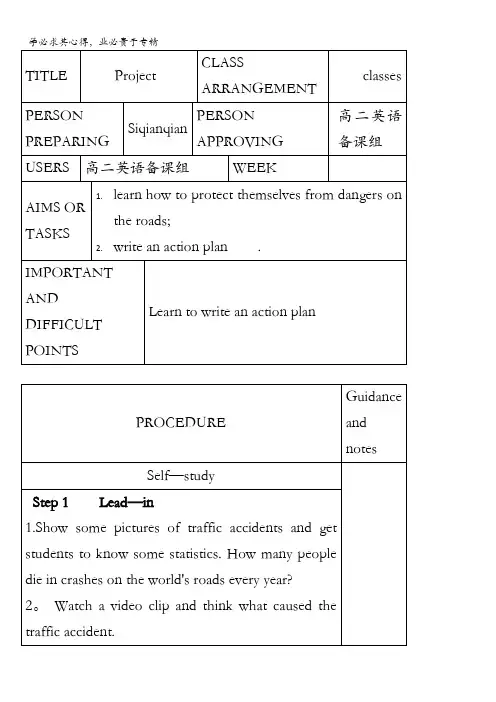
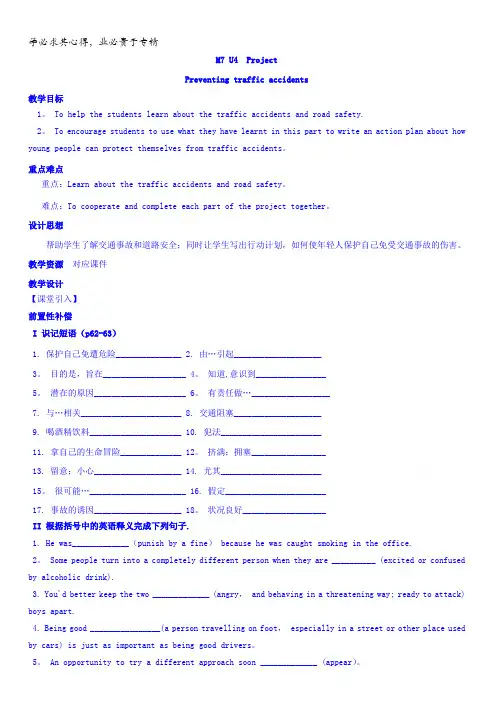
M7 U4 ProjectPreventing traffic accidents教学目标1。
To help the students learn about the traffic accidents and road safety.2。
To encourage students to use what they have learnt in this part to write an action plan about how young people can protect themselves from traffic accidents。
重点难点重点:Learn about the traffic accidents and road safety。
难点:To cooperate and complete each part of the project together。
设计思想帮助学生了解交通事故和道路安全;同时让学生写出行动计划,如何使年轻人保护自己免受交通事故的伤害。
教学资源对应课件教学设计【课堂引入】前置性补偿I 识记短语(p62-63)1. 保护自己免遭危险_______________2. 由…引起____________________3。
目的是,旨在___________________ 4。
知道,意识到________________5。
潜在的原因_____________________ 6。
有责任做…__________________7. 与…相关_______________________ 8. 交通阻塞____________________9. 喝酒精饮料_____________________ 10. 犯法_______________________11. 拿自己的生命冒险______________ 12。
挤满;拥塞_________________13. 留意;小心____________________ 14. 尤其_______________________15。
学必求其心得,业必贵于专精M7U4( Project-— preventing traffic accidents )导学案 Learning aims (学习目标): 1。
Help Ss learn and use English by doing a project 。
2。
Encourage Ss to use what they have learnt to complete a project Important points (学习重点):To analyze the whole text and know about the structure and the main idea of the text Difficult points(学习难点): How to complete the project 。
Learning guides (方法导引): Read, copy and recite Learning procedures (学习过程): Step1。
Try to remember the new words as quickly as possible (温馨提示:说一千,道一万,记住单词是关键!) 1 。
Read and recite new words and phrases from arise to orderly three times 。
(方法导引:按音标正确读,背单词和短语)(A 级) 2 Copy the new words and phrases from arise to orderly three times.(方法导引:汉语只需抄一遍,抄写后应会默写这些单词和短语)(A 级) 3。
根据所给中文释义写出各单词:(方法导引:先默写,然后核对答案,错误之处用红笔标出,写出正确答案后再次加以巩固)(B 级) 1.__________ adj. 极端的,极度的 2。